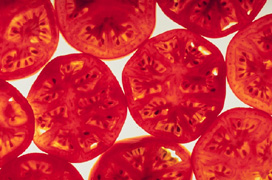This page has been archived and is being provided for reference purposes only. The page is no longer being updated, and therefore, links on the page may be invalid.
Quenching Plants' Thirst--Below Ground
By Marcia WoodDecember 14, 2004
Imagine having a refreshing drink of water brought to you every time you wanted. That happens to thirsty plants irrigated with what's known as a subsurface drip irrigation system. This environmentally friendly technology employs an underground network of sturdy, flexible black tubing to carry water to plant roots, exactly where they need it the most.
About a decade ago, scientists with the Agricultural Research Service's Water Management Research Unit--then located in Fresno, Calif., but now based in nearby Parlier--extensively tested subsurface drip irrigation of tomatoes, cotton and corn. Today, their investigations still remain among the most comprehensive of their kind, documenting that the below-ground systems can provide higher yields while, at the same time, using less water than other systems.
These early findings are important: As competition for high-quality water continues to heat up between farms and cities, some growers are now taking a new look at subsurface drip. Conducted in California's Central Valley, the research is also applicable to farms in many other states.
Subsurface-drip irrigation enables growers to send precise amounts of water to roots. The underground tubing also can transport fertilizers with vital nutrients--like phosphorus and nitrogen.
A buried-drip system can conserve water by allowing growers to apply it more precisely than if they were to choose some other kinds of irrigation equipment, such as overhead sprinklers. This precision helps growers avoid over-irrigating their crops. In turn, they reduce the risk that unused nutrients would be carried by irrigation water into the underground water supply--where they might become pollutants.
What's more, because the water is applied underground, protected from direct exposure to sun and wind, less of it is lost to evaporation.
That's not all. Irrigation water that's applied underground doesn't sit on the soil surface, of course. Keeping the soil surface dry makes it less hospitable for plant-damaging microbes that thrive in moist soil.
ARS is the U.S. Department of Agriculture's chief scientific research agency.

